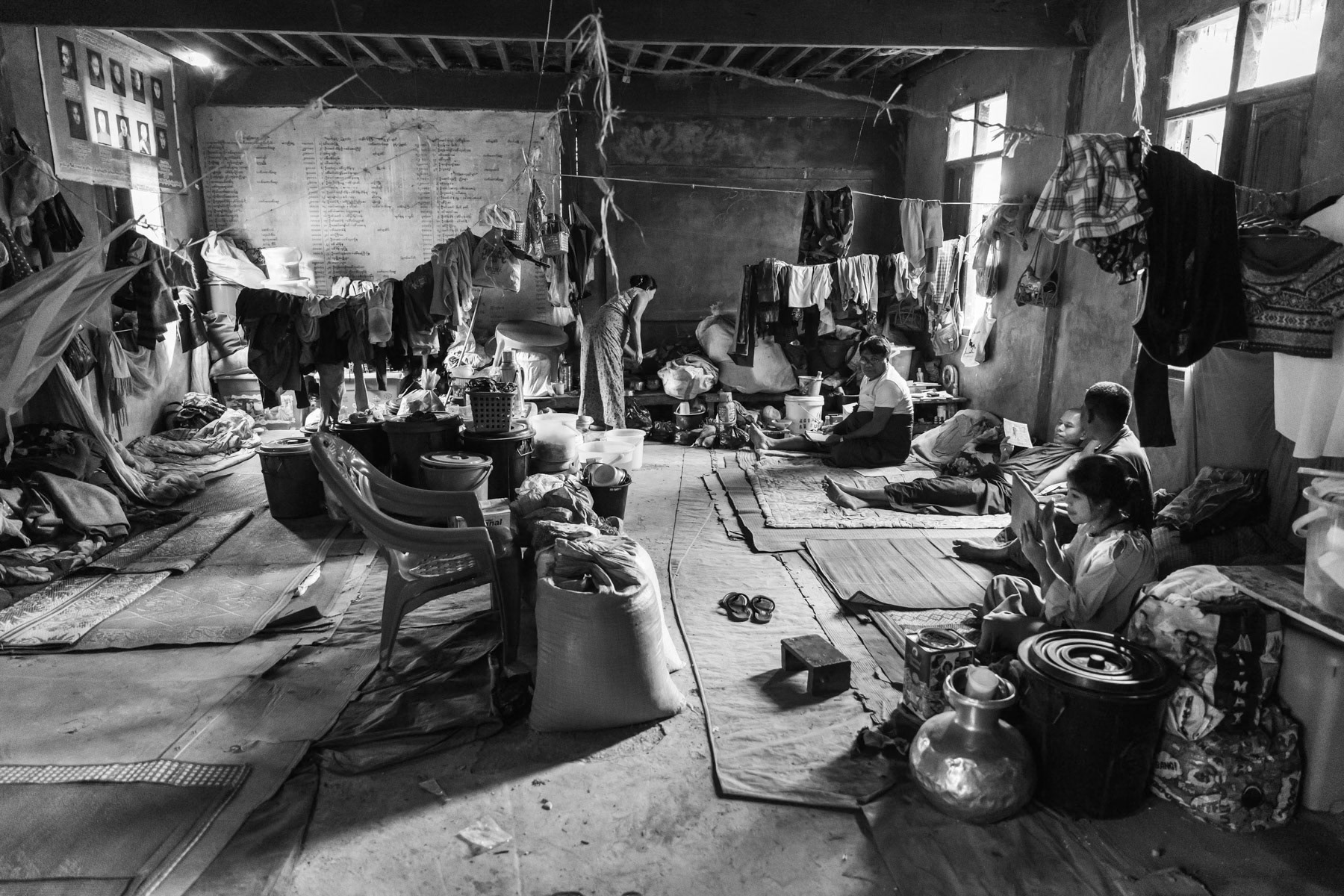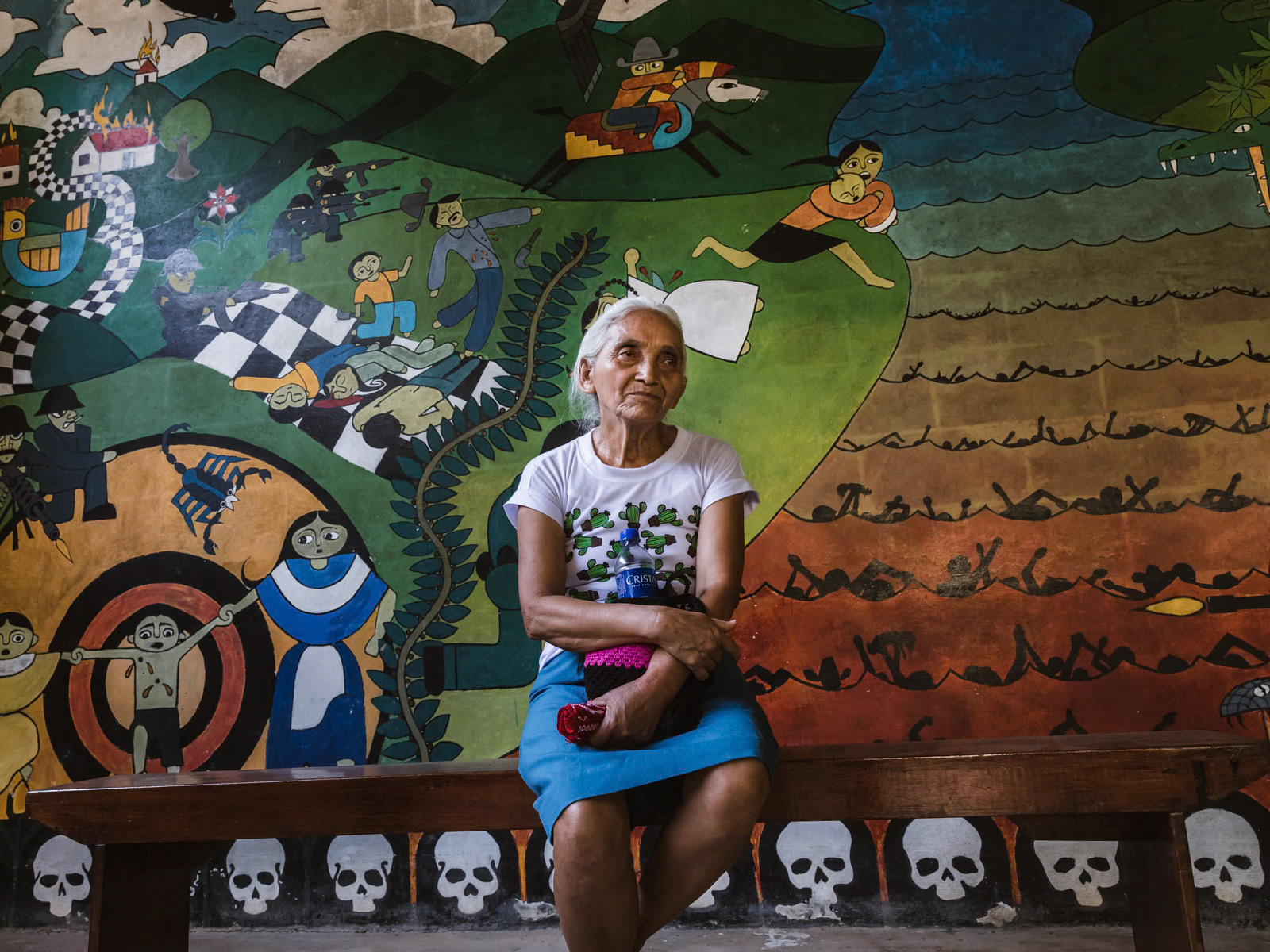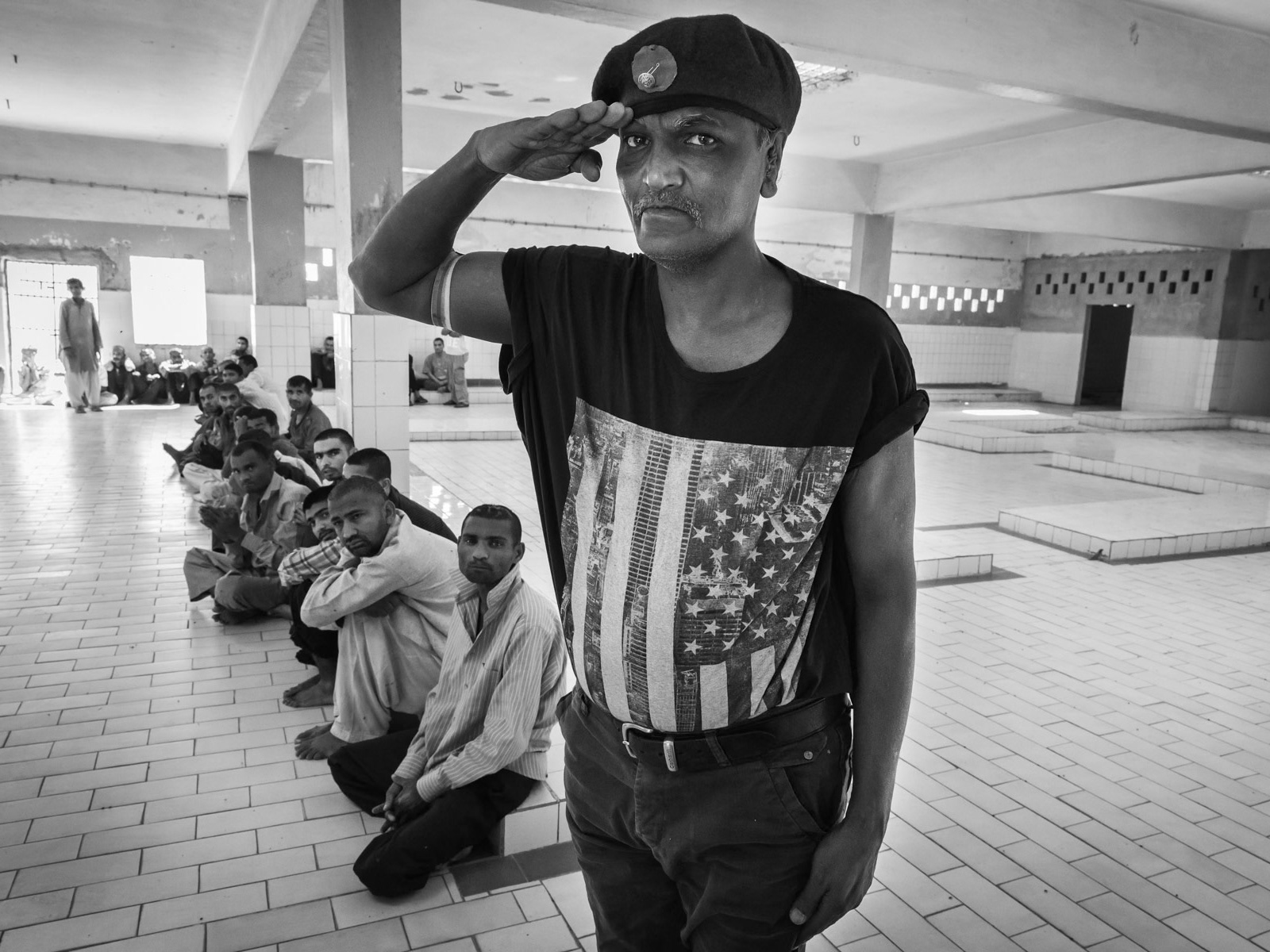Before the military coup of 2021, ethnic minorities in Myanmar, particularly the Karen, Kachin, Rohingya, and Rakhine, endured a long history of discrimination and persecution at the hands of the central military government. The Myanmar military, known as the Tatmadaw, has consistently targeted ethnic groups that sought autonomy or independence, contributing to decades of conflict, violence, and widespread suffering.
The Karen people, one of the largest ethnic groups in Myanmar, have faced systemic repression from the central government for decades. Their resistance to military control has led to violent reprisals, including forced relocation, land grabs, and the destruction of villages. The Karen National Union (KNU), the political arm of the Karen, has led an armed struggle against the military since the 1940s. The Tatmadaw has been accused of committing atrocities, including mass killings, sexual violence, and the use of landmines. Over time, thousands of Karen civilians have been forced to flee their homes, seeking refuge in neighboring Thailand or other parts of Myanmar. Despite this oppression, the Karen have managed to establish self-governance structures in areas they control, with a focus on education, health, and community development.
The Kachin, an ethnic group primarily based in northern Myanmar, have also been the target of systematic discrimination. The Kachin Independence Organization (KIO) and its armed wing, the Kachin Independence Army (KIA), have fought for greater autonomy and the preservation of Kachin culture, language, and land rights. The government’s military operations against the KIA have led to widespread human rights abuses, including aerial bombardments, forced displacement, and the destruction of villages. Many Kachin have sought refuge in China, but many remain trapped in internally displaced persons (IDP) camps within Myanmar. In Kachin-controlled areas, however, community-led initiatives in education, healthcare, and governance have flourished, offering a semblance of self-determination in the face of continued military repression.
The Rohingya, a Muslim ethnic minority in the western Rakhine State, have faced one of the most extreme forms of persecution in Myanmar’s history. Denied citizenship under the 1982 Citizenship Law, the Rohingya have been systematically marginalized and excluded from political, social, and economic rights. The military and Buddhist nationalist groups have targeted the Rohingya with extreme violence, particularly during the 2017 military crackdown that led to what the United Nations described as “genocide.” Thousands were killed, and over 700,000 Rohingya fled to neighboring Bangladesh, where they live in overcrowded refugee camps. The military’s treatment of the Rohingya has drawn international condemnation, but the situation for the Rohingya in Myanmar remains dire, with many still residing in IDP camps or hiding from military attacks.
The Rakhine people, the majority ethnic group in Rakhine State, have also faced discrimination, though not to the extent of the Rohingya. However, they too have been caught in the crossfire of military campaigns, especially as the military has conflated the ethnic Rakhine with the Rohingya Muslim insurgents in their operations. Despite these pressures, ethnic Rakhine have developed some governance and administrative structures through organizations such as the Arakan Liberation Army (ALA), which provides some semblance of local governance and control in areas the government has abandoned. Rakhine leaders have often walked a delicate line between resisting military control and managing relations with the Rohingya minority, whose presence is deeply politicized in the region.
Throughout Myanmar's history, ethnic minorities have sought self-determination, often with little support from the central government, which has viewed them as threats to the unity and integrity of the state. In areas abandoned by the central government, ethnic groups have built their own systems of governance, healthcare, and education. For instance, the Karen, Kachin, and Rakhine have set up community schools, clinics, and other vital services in their autonomous regions, allowing their populations to survive and even thrive despite the challenges. Yet, the constant threat of military offensives, landmines, and displacement has created an environment of instability.
In conclusion, Myanmar’s ethnic minorities have faced systemic discrimination, violence, and marginalization by successive military governments. Despite the hardships, these communities have displayed remarkable resilience, creating governance structures and vital services in areas the state has long abandoned. The central military government’s oppressive tactics have only intensified their struggles, but these minorities have remained steadfast in their pursuit of autonomy, justice, and basic human rights. The situation remains unresolved, and as the country continues to grapple with political instability, the future of these ethnic groups remains uncertain.

There are over a million Kachin people in northern Myanmar and about 150,000 in Yunan, China. Thousands have sought asylum in Thailand and Malaysia following a long lasting guerilla war between the Kachin Independence Army (KIA) and Myanmar government troops. Kachin were originally animist, however as of 1860, British and American missionaries began converting Kachin people to Baptism and other Protestant faiths. Nowadays, nearly all Kachin self-identify as Christians. The church plays today a fundamental role in Kachin's society and social services for the large displaced population. When Burma achieved its independence, the Kachin people got their own State within Burma along strong assurances of significant regional autonomy. Kachin State is very rich in natural resources such as tropical timber, gold, jade and is located in the "Golden Triangle" known for its opium production. Despite autonomy the Burmese government and later the military junta intervened heavily in Kachin's affairs depriving it of its natural wealth and access to development funds. This led militant Kachin leaders to take up arms and form the Kachin Independence Army in 1961, and starting a guerilla war against the government. The war continued relentlessly until a cease-fire in 1994 that lasted until 2011. Despite repeated rounds of negotiations and short-lived cease-fires, fighting has continued with regular occurrence displacing over a 100,000 ethnic Kachin since 2011. Human Rights groups have collected testimony of severe human rights abuses such as land confiscation, mass rape and summary executions by government troops against the Kachin people. As a result of the violence and human rights abuses over a 100,000 ethnic Kachin live in camps for internally displaced persons (IDP) along the Chinese border in KIA controlled territory and in IDP camps in government controlled territory. The humanitarian and psychological situation in the camps is alarming and extremely precarious in KIA controlled territory where humanitarian aid and food only reaches the area sporadically when government troops do not block all access. The border with China is also closed for humanitarian convoys leaving the IDPs in KIA controlled territory in an extremely vulnerable situation and in usually very romote mountain areas. In meanwhile the Myanmar military hinges on their control of these border areas that are extremely lucrative in terms of natural resources (jade and gold), illigal substances (drugs), plantations (banana) and Chinese large scale development projects as the Mytsone dam on the Irrawaddy river. Lambraw IDP camp where 557 people live since April 2018 after being displaced from their village 25 Km away. Namta, Kachin, Myanmar, September 2019
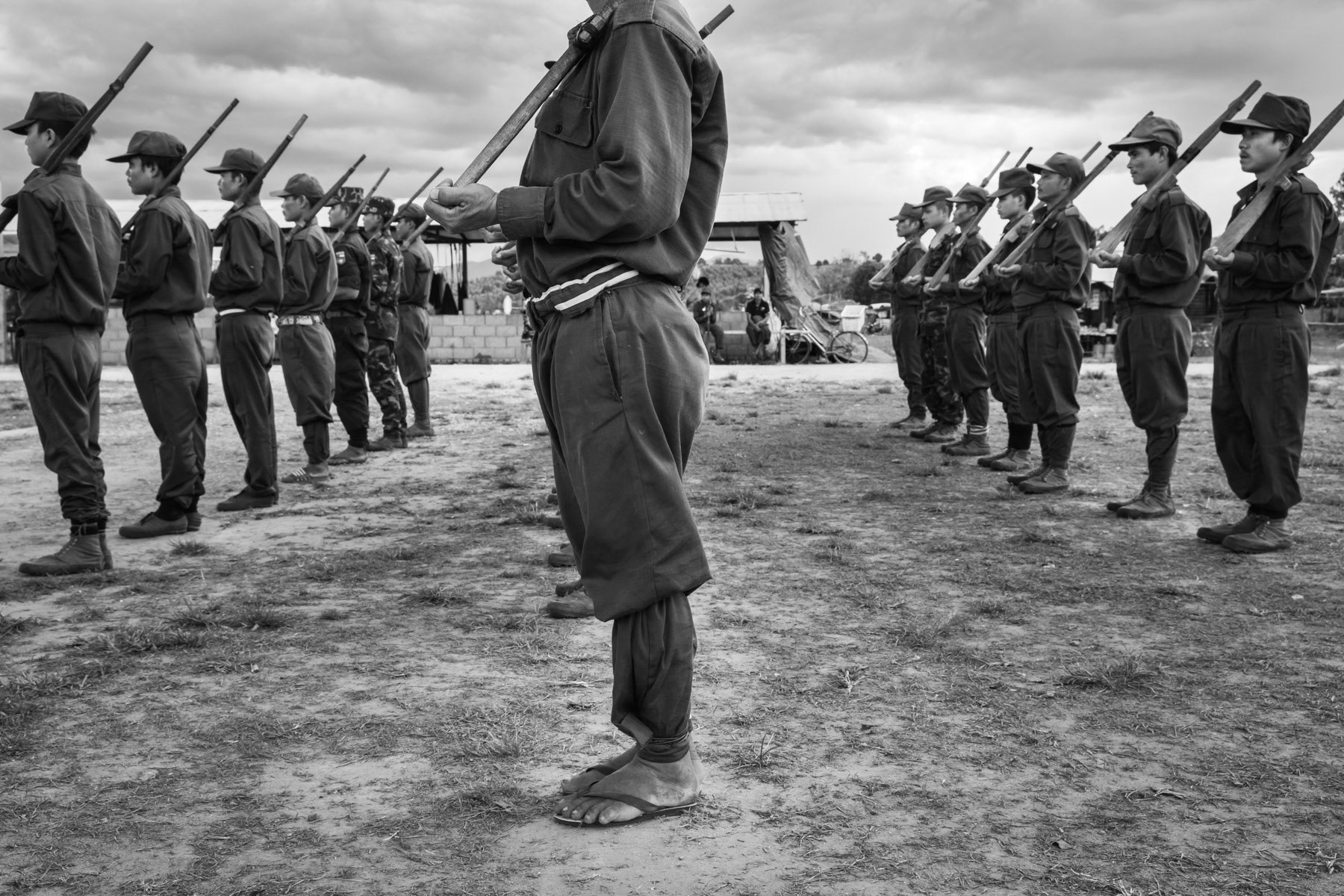
Democratic Karen Buddist Army (DKBA) parade repetition with wooden nep guns. Kayin State, Myanmar, November 2018

Rakhine State, also called Arakan, is again the theatre of armed conflict less than two years after the military's brutal campaign against the Rohingya, which led to the exodus of more than 750,000 people and accusations of genocide. More than 250,000 Rohingya are presently still in Rakhine State scattered in villages and are frequently caught and victim of the armed conflict between Arakanese rebel fighters and the Myanmar military. This time the renewed violence started when in January 2019, police stations were attacked by the Arakan Army (AA) and marked a new chapter in Myanmar's never-ending armed conflicts between ethnic rebel groups and Tatmadaw, the Myanmar military forces. The Arakan Army (AA), established in 2009, is an ethnic Rakhine, religiously Buddhist armed group. AA is part of the Northern Alliance together with Shan ethnic armed groups and the Kachin Independence Army (KIA) and was till 2019 based in Laiza, the headquarters of KIA, in Kachin along the Chinese border where it was training and fighting against government troops alongside KIA. When attacks started in Chin and Rakhine State in 2019, the gravity point of AA swifted from Kachin to Rakhine where they benefit of widespread popular support. With more than 20,000 soldiers, AA, is one of the largest ethnic armed group actively fighting the Myanmar military forces. The ongoing conflict in Rakhine has so far been tightly quarantined from the international community and journalists. An unprecedented government-imposed internet blackout since June 2019 has rendered available information rare and hampered humanitarian assistance due to access and communication restrictions. Amid escalating clashes between AA and the armed forces, and the alleged military abuses against the population, the number of civilian internally displaced persons (IDP) is more than 100,000 all over the region with concentrations in Mrauk-U, Kyauktaw, Rathedaung, Buthidaung, Minbya and Ponnagyun townships. With very limited humanitarian access, squalid camp conditions and the proximity of combat activities, often only few kilometres from the camps, the IDPs but also the general population gets more and more entangled in a very precarious situation with no solution in sight. During the first months of 2020 the conflict has substantially intensified with daily clashes, shelling, civilian casualties, and a more than doubling numbers of displaced persons. Largest IDP camp in Mrauk-Oo township. Nearly 3,000 Arakanese have sought refuge from 12 nearby vilages that are now on the frontline. Over 40,000 people have fled their villages in Rakhine since the armed conflict between the Arakan Army (AA) and government troops started in January 2019. Thein Nyo IDP camp was set up in April 2019, water is only available from a pond. Thein Nyo, Mrauk-Oo township, Rakhine State, Myanmar, October 2019

Kachin child playing in an IDP camp built on a church compound. Over 100,000 Kachin are displaced within the Kachin State since the armed conflict resumed in 2011 between the Myanmar military and the Kachin Independence Army (KIA). Mali Yang IDP camp near Myitkyina in government controlled territory, Myanmar, March 2019

Precarious shelters set up on monastery owned land. With increased fighting between the military and the Arakan Army rebel group more than 100,000 persons have been displaced, Collective centres in monasteries are overcrowded forcing people out in rudimentary shelters with no facilities. Lahakaiza Monastery IDP camp, where more than 500 people found refuge. Mrauk-Oo in Rakhine State, Myanmar, February 2020

Elderly woman of approximately 100 years old living as an internally displaced person in the sole IDP camp in Puta-o the most northern town of Kachin State and Myanmar near the border with India and China. Puta-o IDP Camp, Puta-o, Kachin state, Myanmar, February 2020

Kachin children walking through the rice fields, Puta-o, Kachin State, Myanmar, February 2020

Kachin girl that has been living since 2011 in a camp for internally displaced persons in Kachin State. Over 100,000 Kachin are displaced within their own country as a result of a long lasting armed conflict between the Myanmar Army and the Kachin Independence Army {KIA). Ziun IDP camp in government controlled territory, Myanmar, March 2019

Class for young girls and boys of the Karen ethnic minority, Lae Gho village, Kayin State, Myanmar, November 2018

Women recruits following a military training with a focus on medical aid and nursing. Democratic Karen Buddhist Army (DKBA) training center, Myanmar, November 2018

Kyi Nan IDP camp in Kachin State. More than 100,000 Kachin are still displaced within Kachin State since the armed conflict resumed in 2011 between the Myanmar military and the Kachin Independence Army (KIA). Momauk township in government controlled territory, Myanmar, January 2020

A Karen boy with thanaka on his face. Thanaka is widely used in Myanmar by all ethnic groups to purify and protect the skin. Kayin State, Myanmar, March 2019

The Karen are an ethnic minority of Myanmar and live mainly in the Eastern region of Kayin along the Thai border. The Karen minority makes up approximately 7% of the Burmese population. The Karen movement led mainly by the Karen National Union have waged one of the longest war, since 1949, against the central Burmese government seeking first independence but since the seventies a federal system where the autonomy and rights of ethnic minorities would be respected. During this long conflict numerous Karen sought refuge in Thailand where still over a 100,000 refugees live in refugee camps along the border and in the cities. Karen insurgent groups control large swatches of territory in Eastern Kayin State along the Thai border and try very hard to organise their territory by providing health and education while keeping military forces ready to defend their terrotory and freedom. Democratic Karen Buddist Army recruits following a 3 months long training at a military training center in Karen State. Myanmar, November 2018

Arkanese IDPs in an overcrowded shelter housing 350 displaced persons with insufficient space and sanitary facilities. Conflict escalation between the military and the Arakan Army rebel group has uprooted more than 100,000 civilians since begining 2019. Kyakrit Khee Saw Monastery IDP Camp, Mrauk-Oo, Rakhine, Myanmar, February 2020

Kachin Women attending a mother and child healthcare workshop in a camp for internally displaced persons. Over 100,000 Kachin are displaced within the Kachin State since the armed conflict resumed in 2011 between the Myanmar military and the Kachin Independence Army (KIA). Jan Mai Kuang IDP camp near Myitkyina in government controlled territory, Myanmar, March 2019

Kachin women from the Lazi ethnic sub-group digging along the shores of the Irrawaddy River to find gold and making in average 5-7 USD a day. They are allowed to do this activity for only a couple of months during the winter season. Lazi villages north of Myitkyina, Kachin State, Myanmar, February 2020
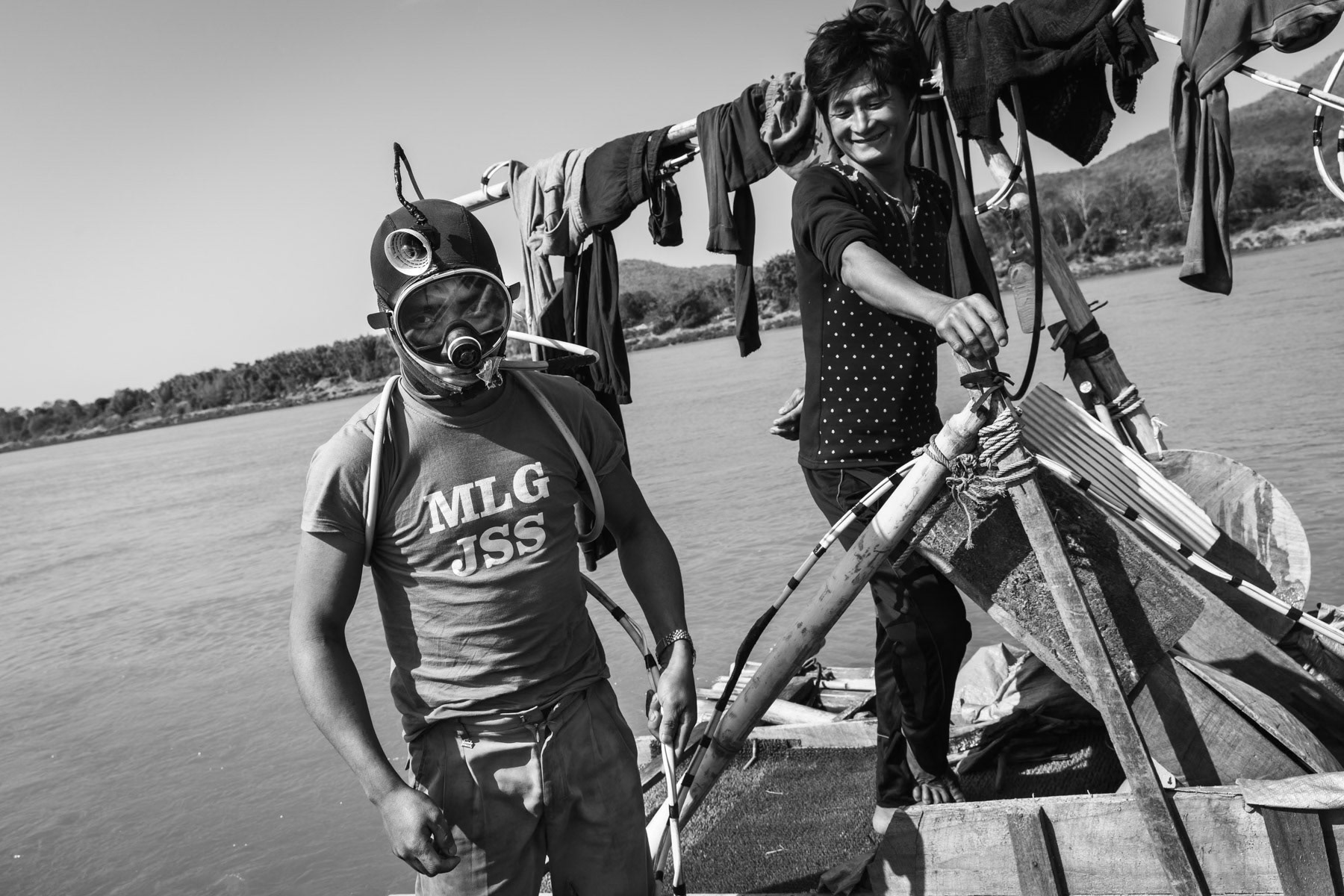
DiEvers on a small scale gold digging raft. Divers dive up to 2 hours at 15 metres depth and up to 2 times per day for about 4 months per year. This health hazardeous activity generates very little income as the large industrial gold digging companies upstream extract the bulk of the gold. Divers are regularly confronted with decompression sickness due to repetitive diving and mercury poisoning. Irrawaddy river north of Myitkyina, Kachin State, Myanmar, March 2019

Camp for internally displaced persons from Kachin State. Over 100,000 Kachin are displaced within the Kachin State since the armed conflict resumed in 2011 between the Myanmar military and the Kachin Independence Army (KIA). Maina IDP camp near Waingmaw in government controlled territory, Myanmar, March 2019

An official memorial ceremony for a General of the Democratic Karen Buddhist Army in Waw Lay village. The DBKA in a Karen minority armed group that is not under contol of the Myanmar Army but with whom a ceasefire has been agreed. Kayin State, Myanmar, March 2019

Kachin children playing in an IDP camp along the border with China in Kachin Independence Army (KIA) held territory in Myanmar. More than 8700 displaced Kachin live in Je Yang camp one hour south of Laiza, the stronghold of the KIA. Je Yang camp in Laiza Township, Myanmar, April 2019

Kachin youth practising martial arts part daily self defense and sports activities. Laiza, the stronghold of the Kachin Independence Organisation controlled territory along the Chinese border. Laiza, Myanmar, April 2019

Karen children competing in a traditional Karen boxing tournament in Waw Lay, Kayin State, Myanmar, March 2019

Nhkawang Pa IDP camp in the mountains of northeastern Kachin State. Over 1700 displaced Kachin live in this camp since 2012 and restart of hostilities between Myanmar military and the Kachin Independence Army (KIA). Mai Ja Yang in KIA controlled territory, Myanmar, April 2019

Kachin children in front of their shelter in Dum Bung camp for internally displaced persons. This IDP camp has 380 residents and is located in a remote area at least 2 hour drive to the first town with medical facilities. Mai Ja Yang district in KIA controlled territory, Kachin, Myanmar, April 2019

A Karen resident of Tar Law Saw village in traditional dress. Hlaing Bwe township, Hpa An Province in Kayin State, Myanmar, November 2018

Kachin women cutting roots and branches to make traditional medecine in the sole IDP camp in Puta-o the most northern town of Kachin State and Myanmar near the border with India and China. Puta-o IDP Camp, Puta-o, Kachin state, Myanmar, February 2020

Ngwi Pyaw San Pya village for returnees in Kachin State. Over 100,000 Kachin are still displaced within Kachin State since the armed conflict resumed in 2011 between the Myanmar military and the Kachin Independence Army (KIA). Myitkyina township in government controlled territory, Myanmar, September 2019

A KNDO soldier that lost his leg during the conflict, playing a traditional Burmese volley-football. Kaw Tho Lei village in Kayin State, Myanmar, March 2019

A mother and her children in a camp for internally displaced persons in Kachin Independence Organisation (KIO) held territory. KIO controlled territory stretches along the Chinese border with the frontline 20-30 miles more inland. Since the outbreak of hostilities in 2011 between the KIO and Myanmar Army, more than 100,000 people have been displaced and settled in camps in government held territories and in KIO controlled territory. Woichyai IDP camp, Laiza, KIA contolled territory in Myanmar, April 2019

Villagers and family of combattants attending a workshop about humanitarian law and protection of civilians during armed conflict. Kaw Tho Lei village in government non-controlled territory. Kayin State, Myanmar, March 2019

Summer class for Kachin children displaced by the ongoing conflict between the Myanmar military forces and the Kachin Independence Army (KIA). Pa Kahtawang IDP camp in KIA controlled territory, Mai Ja Yang, Kachin, Myanmar, April 2019

Land mine victim, 35 years, stepped on a land mine in March 2019 when returning to her village, Zup Mai, to collect wood with 4 other villagers. She had been displaced from the village since April 2018. Was treated in Myitkyina hospital and received a prothisis from ICRC in June 2019. The mine was on the main road at the exit of the village and has most likely been put there by the Burmese military after the conflict of April 2018. Landmines is one of the main reasons why people cannot go back to their villages. Myo Oo IDP camp, Namta, Kachin State, Myanmar, September 2019
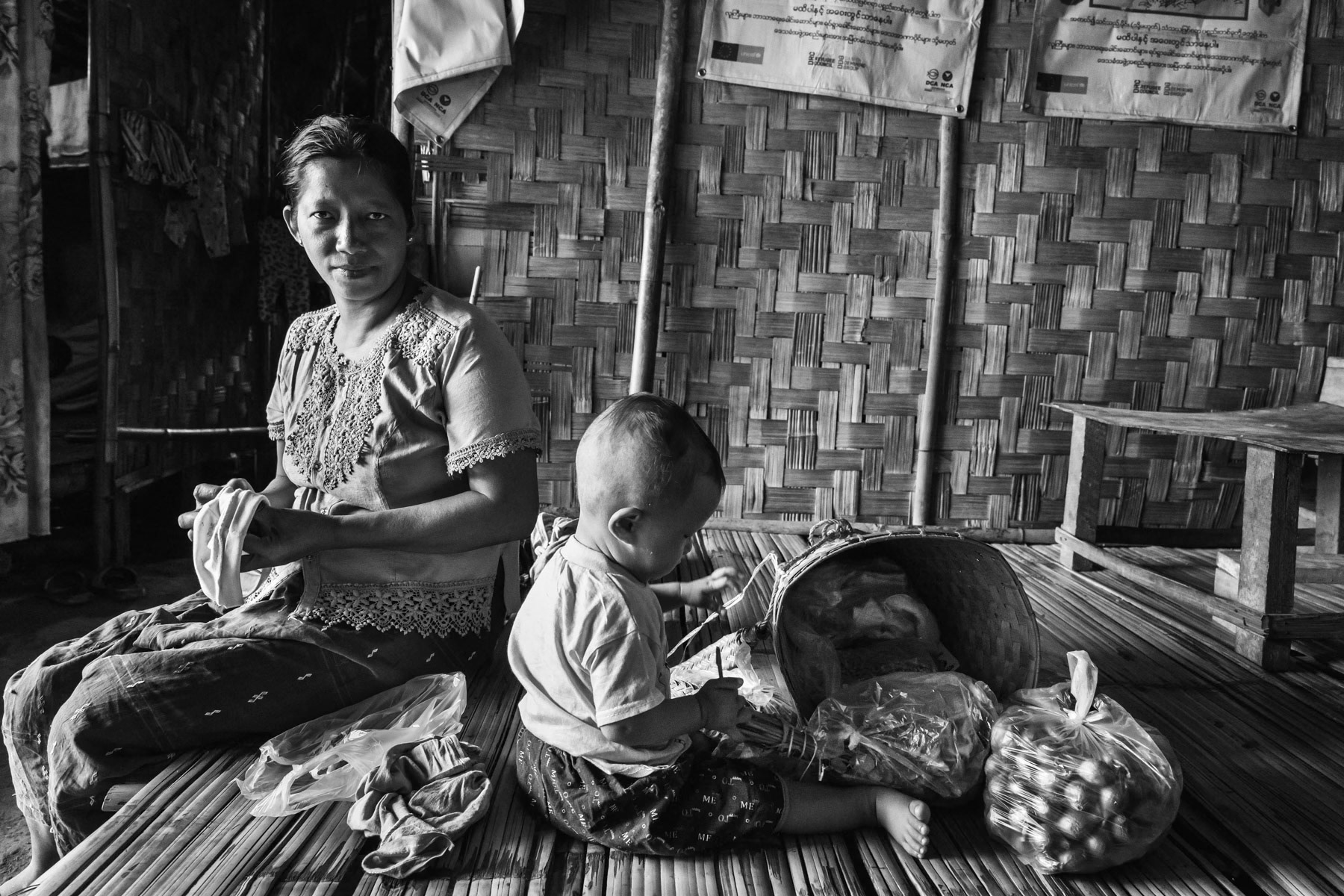
Kachin IDPs in Waimaw Camp 2. Over 100,000 Kachin are still displaced within Kachin State since the armed conflict resumed in 2011 between the Myanmar military and the Kachin Independence Army (KIA). Waimaw township in government controlled territory, Myanmar, September 2019

Thein Nyo is the largest IDP camp in Mrauk-Oo township. Nearly 3,000 Arakanese have sought refuge from 12 nearby vilages that are now on the frontline. Over 40,000 people have fled their villages in Rakhine since the armed conflict between the Arakan Army (AA) and government troops started in January 2019. Thein Nyo IDP camp was set up in April 2019, water is only available from a pond. Thein Nyo, Mrauk-Oo township, Rakhine State, Myanmar, October 2019
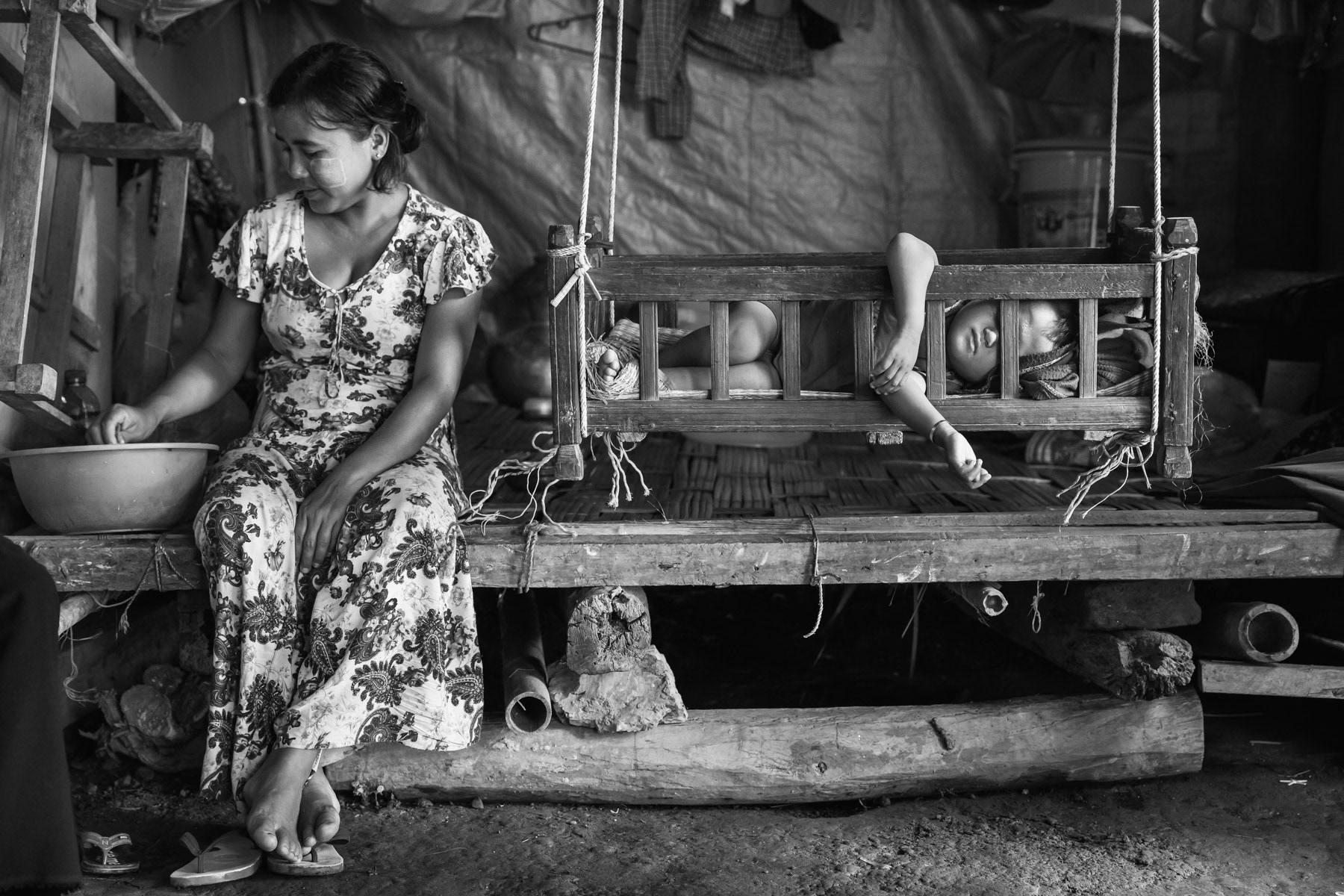
Internal displaced person and her child that fled from Baung Wheit village in April 2019 after the village was attcked by government forces with heavy artillery. Villagers sought refuge at a nearby monastery, only 2 Km from their village. More than 820 people live now on the compound of the monastery. Maut Thein Monastery IDP camp, Mrauk-Oo township, Rakhine State, Myanmar, October 2019

Kachin internal displaced persons living among 400 people on a very small piece of land since 2018 when they fled their village only 25 Km away. Over 100,000 Kachin are displaced within the Kachin State since the armed conflict resumed in 2011 between the Myanmar military and the Kachin Independence Army (KIA). St-Paul IDP camp, Namta, Myanmar, September 2019

Karen villagers building a house with local timber. Taotah village in Kayin State, Myanmar, March 2019
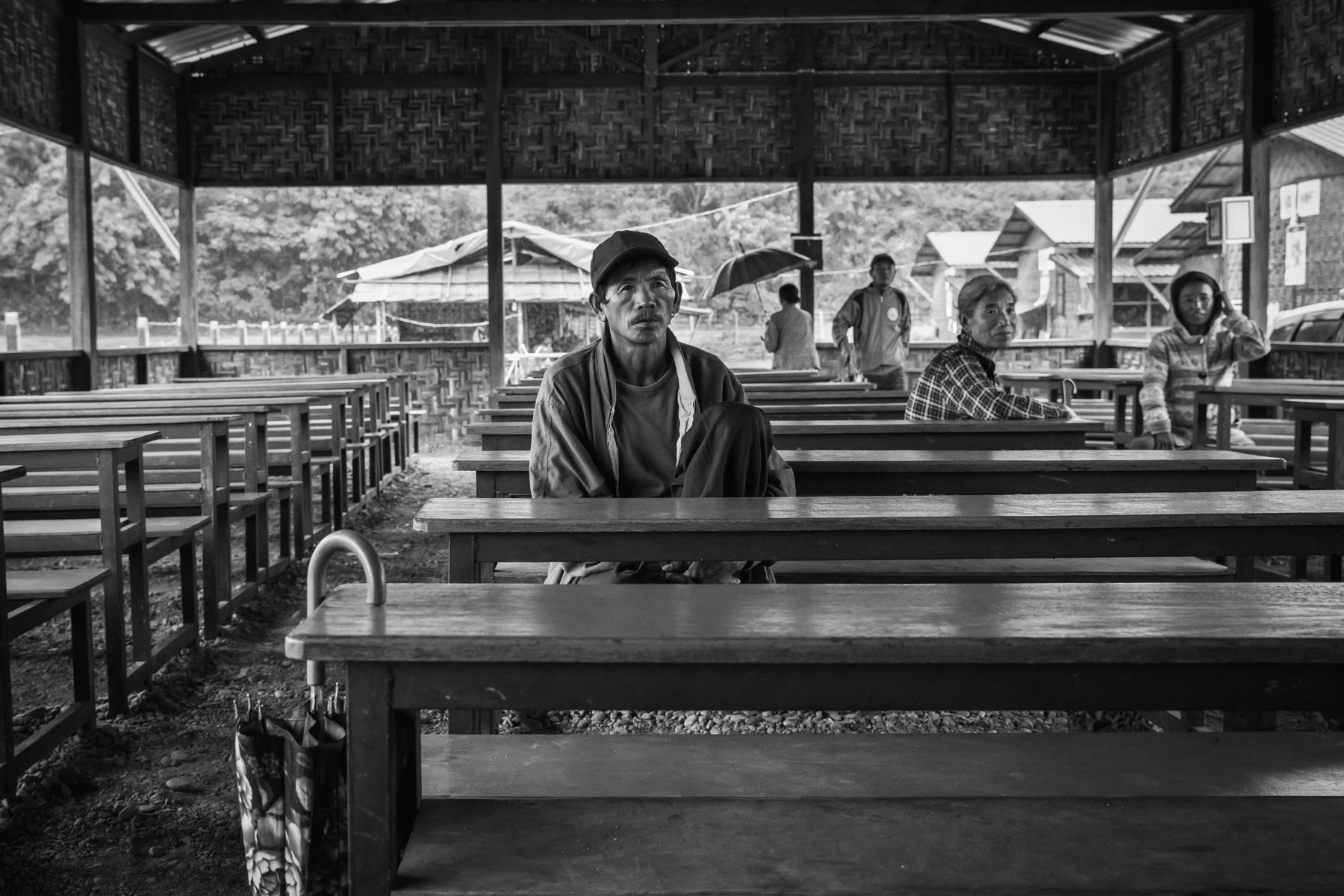
Kachin internal displaced persons living among 560 people since April 2018 in an IDP camp only 25 Km away from their original village from where they had to flee. Over 100,000 Kachin are displaced within the Kachin State since the armed conflict resumed in 2011 between the Myanmar military and the Kachin Independence Army (KIA). Lambraw IDP camp, Namta, Myanmar, September 2019

Arakanese IDP displaced from villages in Buthidaung township where regular combat occures between the Arakan Army (AA) and government troops. Over 40,000 people have been forced to flee since beginning 2019 and are now surviving in a very precarious situation. Da Ma Re Monastery is used to host 200 displaced persons since April 2019. Sittwe, Rakhine State, Myanmar, October 2019

People bathing and washing clothes at a warm water source in Momauk, Kachin State, Myanmar, February 2020
